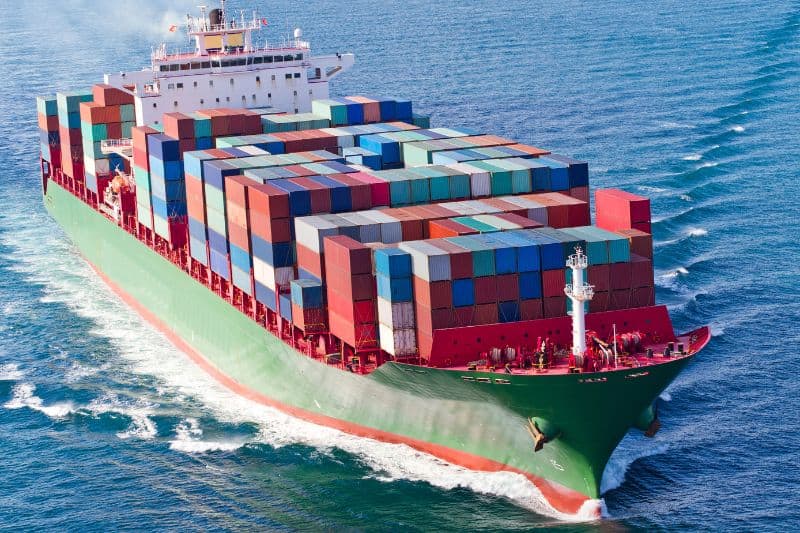When it comes to shipping containers, one of the first questions that might pop into your mind is: “How much does a shipping container weigh?” Knowing the weight of a container is crucial for various reasons, such as calculating transportation costs, handling the container safely, and ensuring compliance with regulations.
Shipping containers come in different shapes, sizes, and types, each having a specific purpose, use, and weight. In this article, we’ll explore the various factors contributing to a shipping container’s weight, including the construction materials and the common sizes available in the market.
It’s important to note that there are two primary weight measurements to consider when dealing with shipping containers. These are the tare weight (the empty container’s weight) and the gross weight (the total weight when the container is fully loaded).
Read: How Much Does 7 Million Dollars Weigh? (Comparison Guide)
A standard 20-foot shipping container typically weighs around 4,916 pounds (2,230 kilograms) when empty. The tare weight of a standard 40-foot shipping container can range from 7,700 to 8,775 pounds (3,490 to 3,980 kilograms).
How Much Does a Shipping Container Weigh?
Knowing the container’s weight is crucial when you’re planning to transport goods in a shipping container. This helps you calculate the shipping cost and ensures your items’ safe and efficient transportation.
There are several types of shipping containers; some of the most common are the 20-foot and 40-foot containers. The weight of a container will depend on its size, material, and construction.
20-Foot Shipping Container
A standard 20-foot shipping container typically weighs around 4,916 pounds (2,230 kilograms) when empty, making it lighter compared to the larger 40-foot version. This is known as the tare weight. Of course, the actual weight of the container will increase once filled with cargo.
- Tare Weight: 4,916 lbs (2,230 kg)
- Max Gross Weight: 66,139 lbs (30,000 kg)
- Max Payload Capacity: 61,223 lbs (27,770 kg)
40-Foot Shipping Container
The 40-foot shipping container is more commonly used for large-scale shipments and is much heavier than the 20-foot version. The tare weight of a standard 40-foot shipping container can range from 7,700 to 8,775 pounds (3,490 to 3,980 kilograms).
- Tare Weight: 7,700 – 8,775 lbs (3,490 – 3,980 kg)
- Max Gross Weight: 88,185 – 92,594 lbs (40,000 – 42,000 kg)
- Max Payload Capacity: 80,415 – 84,819 lbs (36,510 – 38,420 kg)
Remember that these figures are approximate and may vary based on factors such as the container’s manufacturer or the materials used. Always refer to the specific guidelines provided by your shipping container provider to ensure accurate measurements for your particular container.

Basics of Shipping Container Weights
This section will cover the basics of shipping container weights, focusing on the different types of containers, tare weight, and payload weight.
Types of Containers
There are various shipping container types, each with its own weight. Some common container types include:
- Standard dry containers: These are the most common shipping containers, typically used for general cargo. They come in 20-foot, 40-foot, and 45-foot lengths.
- High-cube containers: These containers are similar to standard dry containers but slightly taller, providing extra storage space. They come in 40-foot and 45-foot lengths.
- Refrigerated containers: Also known as “reefers,” these containers are used to transport perishable goods, and have a built-in cooling system. They come in 20-foot and 40-foot lengths.
Tare Weight
The tare weight of a shipping container is its empty weight without any cargo. It considers the container’s structure, materials, and any additional equipment.
Tare weight is important because it helps calculate how much cargo can be loaded into the container without exceeding its total allowable weight. Some approximate tare weights for common shipping containers are:
- 20-foot dry container: 4,600 to 5,000 pounds (2,100 to 2,270 kg)
- 40-foot dry container: 8,000 to 8,600 pounds (3,630 to 3,900 kg)
- 40-foot high-cube container: 8,200 to 8,750 pounds (3,720 to 3,970 kg)
- 20-foot refrigerated container: 6,750 to 7,280 pounds (3,060 to 3,300 kg)
- 40-foot refrigerated container: 9,950 to 10,450 pounds (4,510 to 4,740 kg)
Payload Weight
Payload weight refers to the maximum amount of cargo you can load into a shipping container. To calculate it, subtract the container’s tare weight from its maximum gross weight (the container’s combined weight and contents).
This will ensure your container is not overloaded, keeping your cargo safe during transit. Some approximate payload weights for common shipping containers are:
- 20-foot dry container: 44,000 to 48,600 pounds (20,000 to 22,040 kg)
- 40-foot dry container: 57,000 to 58,600 pounds (25,860 to 26,580 kg)
- 40-foot high-cube container: 56,800 to 58,000 pounds (25,760 to 26,300 kg)
- 20-foot refrigerated container: 39,200 to 43,750 pounds (17,780 to 19,860 kg)
- 40-foot refrigerated container: 57,400 to 58,800 pounds (26,040 to 26,670 kg)
Factors Affecting Container Weight
Manufacturing Material
Most shipping containers are made of steel, accounting for most of their weight. The type of steel used can affect the overall weight of the container. High-quality, corrosion-resistant steel may be lighter than other types but still provide the necessary strength and durability.
Additionally, some containers are made with aluminum, which is significantly lighter than steel. However, it’s important to consider that while aluminum containers weigh less, they may not have the same strength and durability as their steel counterparts.
Container Size
The size of a shipping container directly influences its weight. Containers commonly come in three standard sizes:
- 20-foot containers: These are the most common and typically weigh between 2,200 kg (4,850 lbs) and 2,800 kg (6,170 lbs) when empty.
- 40-foot containers: Weighing between 3,700 kg (8,150 lbs) and 4,200 kg (9,260 lbs) when empty, these are larger and therefore heavier than 20-foot containers.
- 45-foot containers: The largest of the three, these containers can weigh up to 4,800 kg (10,580 lbs) when empty.
Remember, these weights are for empty containers, and the actual weight will increase when they are filled with goods.
Other Components
Aside from the material and size, other components of a shipping container can also play a role in its overall weight:
- Flooring: Container flooring is usually made of plywood, which can significantly impact the container’s weight.
- Doors: Shipping containers come with various types of doors, such as standard, open side, or open top. The type of door and its accompanying locking mechanism can add to the weight.
- Modifications: If a shipping container has been modified with additional features, such as ventilation, insulation, or shelving, the added materials will contribute to the total weight of the container.
Keep these factors in mind when determining the weight of a shipping container. Each component plays a role, so consider the specific details of the container you’re working with.

Beyond the Basics
Gross Weight
Regarding shipping containers, you might be curious about their gross weight. This refers to the combined weight of the empty container, the cargo it holds, and any associated packing materials.
To give you a general idea, a 20-foot container has a typical gross weight of around 24,000 kg (52,910 lbs), while a 40-foot container has a gross weight of around 30,480 kg (67,200 lbs).
Read: How Much Does a Million Dollars Weigh in $1, $20 & $100?
Maximum Operating Weight
Another important aspect to consider is the maximum operating weight. This is the highest weight a shipping container can safely carry while remaining compliant with international transport regulations.
For a 20-foot container, the maximum operating weight is usually around 24,000 kg to 30,480 kg (52,910 lbs to 67,200 lbs). On the other hand, a 40-foot container has a typical maximum operating weight range of 36,000 kg to 42,000 kg (79,366 lbs to 92,594 lbs).
It’s essential to know and respect these limits when you’re shipping goods in containers, as it ensures the safety and efficiency of the transportation process.
Remember, the above information provides a basic overview of the weight aspects of shipping containers. It’s crucial to always check the specifics with the relevant carriers and shipping companies to ensure your cargo complies with all requirements.







